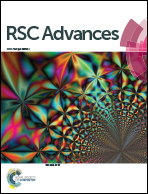Ligand and adjuvant dual-assisted synthesis of highly luminescent and stable Cs4PbBr6 nanoparticles used in LEDs†
Abstract
We developed a new ligand and adjuvant dual-assisted room temperature colloidal method for the synthesis of highly luminescent and stable Cs4PbBr6 nanoparticles, in which acetone, oleamine (OM) and oleic acid (OA) were used as precursors, while water and dimethyl sulfoxide (DMSO) were used as adjuvants. In this process, we explored the influencing factors of process parameters (such as the amount of water, the standing time of precursors, and the molar ratio of raw materials), and found that Cs4PbBr6 synthesized by water + DMSO can not only change the morphology and promote crystallization but also improve the lattice strain, reduce the lattice defects and optimize the passivation effect, so as to improve the luminescence properties. Simultaneously, we also found that the pc-LED made of Cs4PbBr6 can still emit bright green light after 4344 h of operation, showing excellent stability and making it promising for solid-state lighting application. This method also provides an important reference value for solving the hydrolysis property of perovskites.



 Please wait while we load your content...
Please wait while we load your content...